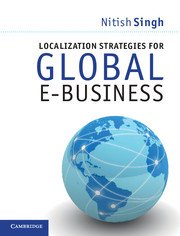Book contents
- Frontmatter
- Contents
- Figures
- Tables
- Preface
- Illustration credits and acknowledgements
- 1 Global e-commerce opportunities and challenges
- 2 International e-business expansion and market entry strategies
- 3 Global online consumer segmentation
- 4 Web globalization strategies
- 5 Developing international websites: internationalization
- 6 Effectively localizing international websites
- 7 Managing a web globalization value chain
- 8 Optimizing international websites
- 9 Assessing web globalization efforts
- 10 Strategic industry insights and emerging localization trends
- Web globalization resources
- Index
- References
10 - Strategic industry insights and emerging localization trends
Published online by Cambridge University Press: 05 June 2012
- Frontmatter
- Contents
- Figures
- Tables
- Preface
- Illustration credits and acknowledgements
- 1 Global e-commerce opportunities and challenges
- 2 International e-business expansion and market entry strategies
- 3 Global online consumer segmentation
- 4 Web globalization strategies
- 5 Developing international websites: internationalization
- 6 Effectively localizing international websites
- 7 Managing a web globalization value chain
- 8 Optimizing international websites
- 9 Assessing web globalization efforts
- 10 Strategic industry insights and emerging localization trends
- Web globalization resources
- Index
- References
Summary
Introduction
The goal of this final chapter is to present emerging trends, opportunities, and challenges that may affect the localization strategies of companies worldwide. Global e-commerce grew immensely in the past decade, and this trend is expected to accelerate. The growth of technologies such as the mobile web, machine translation, and crowdsourcing applications will further enhance global economic activity on the web. In addition, new opportunities in areas of video game localization and global social media localization have yet to be fully leveraged. For example, the social media are spreading rapidly among consumers worldwide, and their commercialization is also on the rise. Marketers now have a better understanding of how to use the social media to both reach global audiences and engage them in a targeted way.
Leveraging social media commercially allows companies to create brand communities and crowdsourcing models, gain consumer insights, enhance product and brand awareness, improve search engine optimization efforts, reduce customer acquisition and service costs, and optimize overall marketing and communication efforts (Scott, 2009; Weinberg, 2009; Stelzner, 2010). Recent social media usage data shows that there are significant differences between countries and regions in the ways that social media are used, content is created, and “crowd wisdom” is shared. Furthermore, 60 percent of the online population is now non-English-speaking; Chinese is the second most popular language used over the internet, with 407 million online users, compared to the 495 million users who speak English (internetworldstats.com).
- Type
- Chapter
- Information
- Localization Strategies for Global E-Business , pp. 269 - 297Publisher: Cambridge University PressPrint publication year: 2011



